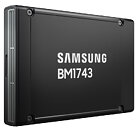- Joined
- Aug 19, 2017
- Messages
- 2,687 (1.00/day)
Samsung has introduced its latest BM1743 SSD, boasting an impressive 61.44 TB of storage capacity. The BM1743 utilizes Samsung's seventh-generation 3D NAND (V-NAND) technology, featuring 176 layers of memory cells. This represents a significant leap from its predecessor, the BM1733, which debuted in 2020 with 96-layer technology and a maximum capacity of 32 TB. Performance-wise, the BM1743 doesn't disappoint. It delivers up to 1.6 million random read IOPS and 110,000 random write IOPS, with sequential read and write speeds of 7.2 GB/s and 2.0 GB/s, respectively. These figures position the drive as a highly capable solution for read-intensive workloads. Samsung claims that the new SSD offers double the sequential read and write speeds of its fifth-generation technology, with random reads quadrupling in performance. This advancement suggests that quad-level cell (QLC) SSDs are now approaching the performance levels of their triple-level cell (TLC) counterparts while offering superior storage density.
The BM1743 is available in the traditional U.2 form factor, with an E3.S variant supporting PCIe Gen 5 also in the lineup, thanks to the custom Samsung controller. Samsung has enhanced the durability and data retention capabilities of the BM1743. The new drive boasts an improved endurance rating of 0.26 drive writes per day (DWPD) throughout its warranty period, a notable increase from the BM1733's 0.18 DWPD. Additionally, the BM1743 extends its power-off data retention to three months, tripling the one-month period of its predecessor. In a hint of things to come, Samsung has suggested that a 122.88 TB model may be on the horizon, potentially doubling the capacity of the BM1743. This new offering puts Samsung in direct competition with Solidigm's D5-P5336, which has dominated the high-capacity SSD market for the past year. High-density storage solutions are becoming more important as AI and HPC tasks require and produce massive amounts of data.

View at TechPowerUp Main Site | Source
The BM1743 is available in the traditional U.2 form factor, with an E3.S variant supporting PCIe Gen 5 also in the lineup, thanks to the custom Samsung controller. Samsung has enhanced the durability and data retention capabilities of the BM1743. The new drive boasts an improved endurance rating of 0.26 drive writes per day (DWPD) throughout its warranty period, a notable increase from the BM1733's 0.18 DWPD. Additionally, the BM1743 extends its power-off data retention to three months, tripling the one-month period of its predecessor. In a hint of things to come, Samsung has suggested that a 122.88 TB model may be on the horizon, potentially doubling the capacity of the BM1743. This new offering puts Samsung in direct competition with Solidigm's D5-P5336, which has dominated the high-capacity SSD market for the past year. High-density storage solutions are becoming more important as AI and HPC tasks require and produce massive amounts of data.

View at TechPowerUp Main Site | Source







